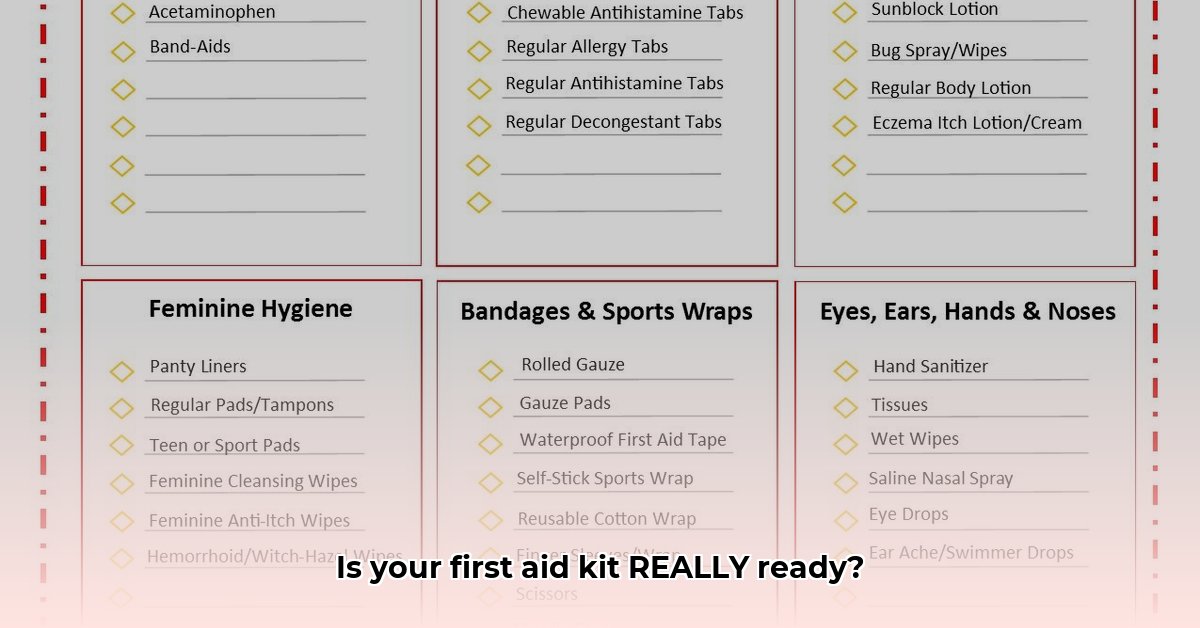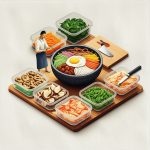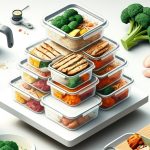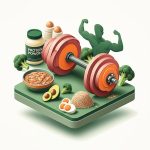Being prepared for life’s little surprises, from scraped knees to unexpected emergencies, is a mark of wisdom, not worry. A well-stocked first aid kit, combined with a little know-how, can make all the difference. This guide walks you through creating a kit tailored to your needs, whether you’re at home, hitting the trail, or on the road.
Building Your First Aid Arsenal
A well-stocked kit isn’t about being overly cautious; it’s about peace of mind. This checklist helps you build a kit that’s right for you.
Home & Travel Essentials
For everyday mishaps, these basics are key:
- Adhesive Bandages (Assorted Sizes): From fingertip nicks to larger scrapes, a variety of sizes is essential.
- Antiseptic Wipes: Clean wounds effectively and hygienically before bandaging.
- Gauze Pads (Various Sizes): Provide cushioning and absorption for larger wounds or burns.
- Medical Tape: Secure dressings, create makeshift butterfly bandages, or support injured fingers.
- Pain Relievers: Ibuprofen reduces inflammation, while acetaminophen tackles fever and pain. Some experts suggest having both.
- Antihistamine (Oral & Topical): Quickly address allergic reactions, from hives to bug bites.
- Hydrocortisone Cream: Soothes itchy rashes, insect bites, and minor skin irritations.
- Tweezers: Precisely remove splinters, ticks, and other foreign objects.
Hiking & Camping Additions
Venturing outdoors? Pack these extras:
- Blister Treatment: Blister pads and moleskin prevent and treat painful hotspots. Prevention is key!
- Triangular Bandage: Versatile for slings, splints, or securing dressings. Learning basic techniques is valuable.
- Safety Pins: Surprisingly useful for fastening bandages, torn clothing, and more.
- Scissors: Trim bandages and clothing safely.
- Antibiotic Ointment: Creates a protective barrier against infection in deeper cuts.
- Instant Cold Packs: Soothe swelling and pain from sprains and strains. Wrap in a cloth before applying directly to skin.
- Irrigation Syringe: Flush out dirt and debris from wounds, reducing infection risk.
Wilderness & Remote Area Preparedness
When help is far away, these items become crucial:
- Tourniquet: Controls severe bleeding. Wilderness first aid training is highly recommended for safe and effective use. Researchers are constantly evaluating tourniquet use and design, so staying updated on best practices is crucial.
- SAM Splint: A lightweight, moldable splint to immobilize fractures. Practice using it before heading out. While generally effective, ongoing research continually refines splint design and application methods.
- Emergency Blanket: Prevents hypothermia in cold or wet conditions.
- Whistle: Signals for help over long distances.
- Water Purification Tablets: Ensures safe drinking water when sources are questionable.
- Duct Tape (Small Roll): A surprisingly versatile tool for repairs and makeshift bandages.
Kit Maintenance Essentials
Keep your kit ready for action:
- Check Expiration Dates: Regularly replace expired medications and supplies.
- Restock After Use: Replenish used items immediately to maintain readiness.
- Store Properly: Keep your kit in a cool, dry place, ideally in a clear, waterproof container.
Home First Aid: Your Health Hub
Your home first aid kit is your first line of defense against everyday injuries and illnesses. Organize it effectively, and familiarize yourself with its contents.
Wound Care
Everything you need to patch things up:
- Bandages: Assorted sizes for various wounds.
- Gauze Pads & Rolls: Cushion and protect wounds, absorbing fluids.
- Antiseptic Wipes: Cleanse the area before applying a bandage.
- Antibiotic Ointment: Helps prevent infection.
- Hydrocortisone Cream: Eases itching and inflammation.
Medications
Over-the-counter relief for common ailments:
- Pain Relievers (Ibuprofen, Acetaminophen): Address pain and fever.
- Antihistamines: Relieve allergy symptoms.
- Bismuth Subsalicylate/Loperamide: Settle upset stomachs.
- Throat Lozenges/Cold Medicine: Soothe cold and flu symptoms. Note on Aspirin: While effective, avoid giving it to children due to the risk of Reye’s syndrome, which is still under investigation.
Tools & Essentials
The supporting players in effective first aid:
- Scissors: Cut bandages and other materials.
- Tweezers: Remove splinters and foreign objects.
- Finger Splints: Stabilize minor fractures.
- Thermometer: Monitor fevers.
- Non-Latex Gloves: Maintain hygiene.
- Cold/Heat Packs: Soothe pain and swelling.
- Breathing Barrier (for CPR): Enable safe rescue breaths.
- Emergency Blanket: Regulate body temperature.
Emergency Preparedness
Beyond everyday needs, consider these for unexpected events:
- Bottled Water: Essential for hydration.
- Non-Perishable Food: Provides sustenance during emergencies.
- Radio (Hand-Crank/Battery-Powered): Stay informed.
- Flashlight & Portable Phone Charger: Provide light and communication.
- Emergency Contact List (Physical & Digital): Quickly reach loved ones and services.
- Personal Prescription Medications (One Week Supply): Maintain access to essential medications.
Car Emergency Kit: Roadside Ready
Being prepared on the road is just as important as being prepared at home. Your car emergency kit should cover common roadside issues and unexpected events.
Wound Care
For minor injuries on the go:
- Antiseptic Wipes: Cleanse wounds.
- Band-aids (Assorted Sizes): Cover minor cuts and scrapes.
- Sterile Gauze Pads & Adhesive Tape: Dress larger wounds.
- Butterfly Closures: Help close deeper cuts.
- Antibiotic Ointment: Prevent infection.
- Hydrocortisone Cream & Burn Ointment: Treat burns and skin irritations.
Pain & Discomfort Relief
Manage common aches and pains:
- Over-the-Counter Pain Relievers: Address headaches, muscle cramps, and other minor pains.
- Aspirin: Consult a doctor before using for potential heart attack symptoms. Its effectiveness in such situations is still researched.
- Medications in Original Containers: Ensure proper identification and dosage instructions.
Essential Gear & Tools
The practical helpers in any roadside situation:
- Blunt-Tipped Scissors: Cut bandages, clothing, or seatbelts.
- Tweezers: Remove splinters and foreign objects.
- Safety Pins: Secure bandages or clothing.
- Instant Cold Packs: Reduce swelling.
- Gloves: Protect against bodily fluids.
- CPR Face Shield: Ensure safe rescue breaths.
- Hand Towel: Clean up spills or apply pressure to wounds.
- Hand Sanitizer: Maintain hygiene.
- Bottled Water (Replace Regularly): Stay hydrated.
Personalized Additions
Tailor your kit to your individual needs:
- Allergy Medications (Clearly Labeled): Address allergic reactions.
- Supplies for Pre-Existing Conditions: Manage specific medical needs.
- Anti-Nausea Medication: Combat motion sickness.
- Eye Drops: Soothe irritated eyes.
- Insect Repellent: Prevent bug bites. Consult with your doctor before adding any medications.
Car Emergency Kit Checklist (Table Format)
| Category | Item | Notes |
|---|---|---|
| Wound Care | Band-aids (assorted) | |
| Gauze Pads/Tape | ||
| Antiseptic Wipes | ||
| Butterfly Closures | Consider for deeper cuts. | |
| Antibiotic/Burn Ointment | ||
| Hydrocortisone Cream | ||
| Pain Relief | Ibuprofen/Acetaminophen | |
| Aspirin | Consult doctor before using for heart attack symptoms. Ongoing research may clarify appropriate usage | |
| Tools/Essentials | Scissors (blunt-tipped) | |
| Tweezers | ||
| Safety Pins | ||
| Cold Packs | ||
| Gloves (non-latex) | ||
| CPR Face Shield | ||
| Hand Towel | ||
| Hand Sanitizer | ||
| Bottled Water (replace regularly) | ||
| Other Essentials | First Aid Manual | |
| Flashlight/Extra Batteries | ||
| Emergency Blanket | ||
| Whistle |
Remember, this information is for guidance only and does not replace professional medical advice. Consult with a healthcare provider or certified first aid instructor for personalized recommendations. Ongoing research continually evolves best practices in first aid and emergency preparedness. Stay informed and adapt your kit as needed.
- Your Perfect Bento Box Bag For Fresh And Tidy Meals - December 2, 2025
- Korean Meal Prep Made Easy For Delicious Weekday Meals - December 1, 2025
- Korean Food Meal Prep Makes Flavorful Weekday Meals Simple - November 30, 2025










